Author: Dawn Archer Pizzoferrato, ABCDT, owner of Arrow Dog Training.
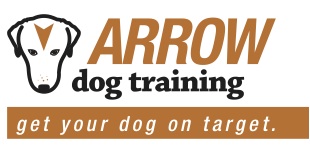 Most dog owners know that their dogs need exercise. But most don’t know how important this need is to the relationship between dog and owner and many dog owners don’t know how much and even more importantly what kind of exercise their dog needs.
Most dog owners know that their dogs need exercise. But most don’t know how important this need is to the relationship between dog and owner and many dog owners don’t know how much and even more importantly what kind of exercise their dog needs.
There are all sorts of fallacies regarding exercise: Small dogs need less exercise and large dogs need more. If you have a large yard where your dog can run free, he will get enough exercise. If you play fetch with your dog for a few minutes each day your dog is getting plenty of exercise. Well, these are all false. There are many small breed dogs (Terriers come to mind) that need much more exercise than large breed dogs (Great Danes also come to mind). And in my opinion, a romp in the back yard after you come home from work with a few minutes of fetch is simply not enough exercise for most adult dogs.
Dogs need to walk. That’s what they do. Yes, they are great runners and absolutely love it, but walking (or a trot) is their natural pace for getting around in the world. So as the “Pack Leader” it is our responsibility to walk with our dogs. Did you notice I wrote, “walk with our dogs”? That’s because that is really how it should be. Your dog shouldn’t be pulling on you and you shouldn’t have to be pulling on your dog. It should be a calm, stress-free, relaxing yet focused time for both of you. When a group (pack) of dogs walk together they are bonding. They establishing and strengthening their roles in the pack.
So how do you make that happen? Well, first let’s discuss WHEN to walk your dog. It is my belief that dogs should be walked BEFORE being fed. I don’t think it matters whether it is in the morning or evening. It just needs to be before they are fed. Why, Do you ask? I have two reasons. One-it is the natural order of things for dogs. A dog wakes up in the morning, goes for a walk “looking” for food, eats, then naps. Walking is how a dog “works” for it’s food. We all must work for our food, and so should your dog. No free-rides allowed. Two-If you have a dog prone to Bloat (the deadly problem when the stomach fills with air and can possibly twist), it’s important that your dog does not exercise after eating.
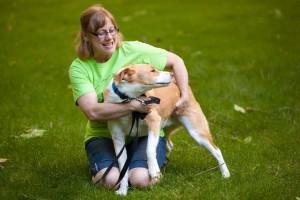 So you’re ready to walk, now is the time to start acting like a leader. It is important that you initiate the walk. If your dog is begging you to go walk and you do, who is the leader? Your dog is. Just wait (taking away your attention) until your dog is calm and make the walk a reward for it’s calm behavior. Now make your dog “sit” and be calm while you put on the leash. If your dog can’t sit still, put the leash down and walk away. When your dog is calmer, have her “sit”, then try again. This may take awhile the first time, so give yourself plenty of time so you can be patient. Pack Leaders do not lose their patience.
So you’re ready to walk, now is the time to start acting like a leader. It is important that you initiate the walk. If your dog is begging you to go walk and you do, who is the leader? Your dog is. Just wait (taking away your attention) until your dog is calm and make the walk a reward for it’s calm behavior. Now make your dog “sit” and be calm while you put on the leash. If your dog can’t sit still, put the leash down and walk away. When your dog is calmer, have her “sit”, then try again. This may take awhile the first time, so give yourself plenty of time so you can be patient. Pack Leaders do not lose their patience.
This might be a good time to talk about equipment. If your dog is capable of walking on a “loose” leash, all you need is a flat buckle collar and a regular 6-foot nylon or leather leash. I am not a fan of “Flexi leads”, choke chains or prong collars. If your dog is a puller or a lunger, a head collar or anti-pull halter (Halti, ControlEase, Gentle Leader or Canny Collar) is usually an instant fix. They provide a natural deterrent to pulling by making the head (or chest in the case of the halter) pull BACK when the dog is pulling forward. It is wonderful and preferable that your dog learns to walk on loose leash with just a flat collar. But it is perfectly acceptable to use and always use a head collar or anti-pull halter. It is important to know that a regular halter will actually PROMOTE pulling in dog that tends to pull. This is called “oppositional reflex” which causes them to pull against anything that’s pulling against them.
Donned with all the right equipment, you are now ready to proceed on your walk. But first you have to get out the door. Your dog should sit and WAIT for you to open the door. Allowing your dog to bolt out an open door again tells your dog that he is the leader. So ask your dog to “sit” then start to open the door. If your dog moves out of the “sit,” close the door, ask for a “sit” again then start to open the door again. You need to keep doing this until you can open the door all the way without your dog moving. Now go through the door AHEAD of your dog. From now on you will exit or enter a door AHEAD of your dog. Okay, now walk!
Are you walking beside your dog, “with your dog”? Or is your dog walking ahead of you, sniffing the ground, stopping to pee on every tree? If the former is true, just keep going; don’t stop for at least 2-3 blocks. If you sense your dog needs to relieve itself, YOU decide where and when. When your dog is done, start up again and walk. If you have a working dog, get a backpack and have him carry a couple bottles of water. When you have a breed that was bread to work, you MUST fulfill that need in them. I have 3-4 different routes I take around my neighborhood and I alternate between them. This way my dogs have a slightly varied route everyday with different smells, sights and sounds. This helps keep them engaged while walking. Their brains will be working as much as their brawn.
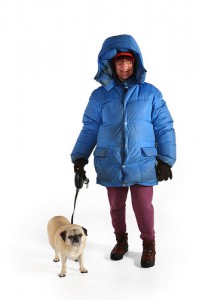 If your dog pulls out ahead of you, stopping to sniff every tree, a quick collar correction before your dog gets to end of the leash is quite appropriate. But it must happen before there is any tension on the leash, be quick and strong enough to get your dog to IMMEDIATELY turn back to you and then you must immediately create slack in the leash again. If your dog is wearing a head collar or anti-pull harness, stop in place until your dog moves back towards you and takes the tension off the leash before proceeding forward. If pulling continues, stop, say “EH, EH” and change direction. Do this as often as necessary to stop any pulling. Same thing goes for a dog lagging behind, don’t wait for him, keep going and encourage with voice for them to catch up. Talk to your dog when he is doing a good job and keep your pace up. Your dog is more likely to keep up with you and to be less interested in extrinsic distractions if you are walking at a fun pace for your dog. Keeping up this pace will help keep your dog focused. When you have the perfect walk, you’ll know it. You’re relaxed, you’re holding the leash gently, and there is plenty of slack on the leash. You are aware of your dog, but not focused on him. Your dog is aware of you, but also not focused on you. You each check in once in while, but you keep moving ahead.
If your dog pulls out ahead of you, stopping to sniff every tree, a quick collar correction before your dog gets to end of the leash is quite appropriate. But it must happen before there is any tension on the leash, be quick and strong enough to get your dog to IMMEDIATELY turn back to you and then you must immediately create slack in the leash again. If your dog is wearing a head collar or anti-pull harness, stop in place until your dog moves back towards you and takes the tension off the leash before proceeding forward. If pulling continues, stop, say “EH, EH” and change direction. Do this as often as necessary to stop any pulling. Same thing goes for a dog lagging behind, don’t wait for him, keep going and encourage with voice for them to catch up. Talk to your dog when he is doing a good job and keep your pace up. Your dog is more likely to keep up with you and to be less interested in extrinsic distractions if you are walking at a fun pace for your dog. Keeping up this pace will help keep your dog focused. When you have the perfect walk, you’ll know it. You’re relaxed, you’re holding the leash gently, and there is plenty of slack on the leash. You are aware of your dog, but not focused on him. Your dog is aware of you, but also not focused on you. You each check in once in while, but you keep moving ahead.
Every walk, even for the smallest dog should last at least 20 minutes. If you have a larger or more energetic dog, they may need as much as an hour, twice a day. Your dog should have a good pant going on when you return home — where you enter through the door ahead of your dog.
Remember, your walk with your dog is your greatest opportunity to establish your leadership and to bond with your dog. It’s when you can live in the NOW with your best friend, and free yourself from all the junk you have to deal with the rest of your day. It’s one of the healthiest things you can do for yourself and your dog!
Learn More About Dawn & How to Get Your Dog On Target!
Dawn is an Animal Behavior College Certified Dog Trainer, an experienced Nose Work Instructor, an AKC Canine Good Citizen evaluator, and the owner of Arrow Dog Training.
Dawn is AnnaBelle’s resident clicker training specialist and she can help you Get Your Dog on Target! Dawn uses scientifically proven “clicker training” and “free shaping” to teach your dog all the basics plus other fun, useful behaviors. She uses operant conditioning and positive reinforcement, without correction, to help you and your dog build a bond of trust and respect.
In addition to presenting Doggie Do Good clicker classes, Dawn also offers Nose Work classes, TDI® (Therapy Dog International) classes and in-home private training. Dawn’s group classes are taught at AnnaBelle’s on Tuesday and Wednesday evenings. Click here to see her complete class schedule!
Article may not be reprinted without express written permission
Dawn Pizzoferrato, owner of Arrow Dog Training, offers clicker training classes for dogs of all breeds and sizes in groups on Wednesday evenings at AnnaBelle’s Pet Station and privately through in-home training. Certified as a dog trainer through the Animal Behavior College, she says, “My focus has always been on pet dogs and creating a positive home environment with their human parents so that it will become their ‘forever’ home.”
As benefits of the clicker method, Pizzoferrato shares that as both a training tool and a communication device, the clicker works better than verbal cues due to its consistency in tone and volume. She cites the speed at which the method works as one major benefit, adding, “I feel the biggest advantage to the clicker training method is the bond it creates between owner and dog. Clicker training is a mutual learning experience. While the owner is trying to get behaviors from the dog, the dog is also trying to get the owner to click.” This lends itself to endless training possibilities.
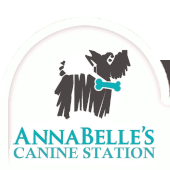

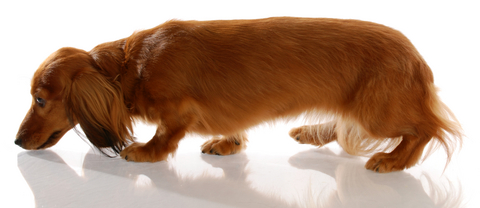
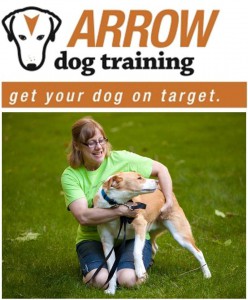
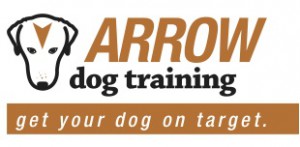

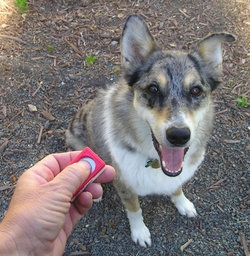 So, in other words, this means that the clicker sound needs no interpretation. Once the dog learns that a treat follows a click and learns that to get a click he needs to do a requested behavior,
So, in other words, this means that the clicker sound needs no interpretation. Once the dog learns that a treat follows a click and learns that to get a click he needs to do a requested behavior, 

